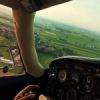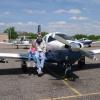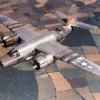Leaderboard
Popular Content
Showing content with the highest reputation on 09/19/2015 in all areas
-
3 points
-
A pita, yes. A deficiency, not in my opinion. I fly a lot with my gear firmly down. Every time I take off and land.2 points
-
I have read articles in aviation magazines about possible cumulative effects from flight 8-12K, where mild hypoxia may be present. The onset is, of course, highly variable between people, and also variable over time for a given individual as they age and their health and fitness levels fluctuate. is this something that those of us who never fly in the Oxygen levels need to worry about? My C just won't go that high, and climb rates are generally T or below 500 fpm by 10K if not before. No, I do not own an oxygen system nor a pulse ox meter.2 points
-
ross . well i'll be damned ! On the turn coordinator . yep. it even says roll trim . Clarence , the mooney i flew in before had it on the yoke . i assumed this one just didn,t have it . which was the reason for the rubber stopper from a crutch jammed over the yoke button.. really. electric trim... oh my2 points
-
Remember, what you see, is what is there right now (maybe). What you will get is what develops when you get there. My flying involved hundreds of flights every day to commute from island to mainland and the flights were only twenty minutes or less. So I have many hundreds of instrument approaches in serious fog, but I never got used to flying hundreds of miles crossing cold fronts. If you create a record of being too careful over many years you have a great record. If you think that the chance of having serious problems is less than one chance in a hundred, then you can expect to have serious problems if you do that something hundreds of times.2 points
-
Many years ago I had the opportunity to go for a ride in a Cristen Eagle out of Hayward CA. We flew out to the practice area east of LVK and the pilot Erve (he was a competition aerobic pilot) flew his entire routine we pulled over 6 G's on several manuvers and I never even got the least bit nauseous. The thing he did that made it so was as we entered each manuver he would instruct me on where to fix my eyes through each part of the event. He also narrated as he controlled the airplane. It was a fantastic experience one I will never forget.2 points
-
Looks like most of the Mooney bike enthusiasts are road bikers. My wife and I have used our Mooney on mountain biking trips and even carried a car rack with 2 29er MTB's. A couple not so good images follow, the first shows the bikes packed without the wheel bags In yet. The bikes are packed in light bags with seats and wheels removed - keeps everything clean. second picture shows everything on the ramp while packing for the return trip. Sent from my iPad using Tapatalk1 point
-
Flying "in" IMC is easy and not particularly scary. Flying up into the clouds gives me a few seconds of near panic until I get acclimated. Flying down out of the clouds is not too bad until I get to about 1000 AGL, and then the pucker factor keeps going up until I break out.1 point
-
Ok, I love the new format, but the lack of this feature was driving me nuts. But once I figured out what software is being used for this forum and did some Googling, I was able to solve it. I check this forum more times each day than I'd like to admit. And I always start by clicking the New Content as in the red box in the screen shot. What I discovered is that if you click on the dot next to the forum title, it will take you to the first unread post, or where you left off reading the last time. (Marked by the red arrow)1 point
-
I do think >=95% is a good guideline - in absence of CO-poisoning, this SaO2 level pretty much takes hypoxia concerns off the table for a healthy pilot. Any number below 90 is very alarming by the following reasoning: Our measurement of O2 sat% (SaO2) on our finger reflects hemoglobin saturation, which is the single best measure of content of the blood. This is because much more O2 is loaded on hemoglobin than dissolved free in the blood. The relationship between SaO2 and partial pressure of dissolved O2 in the blood (PaO2) is not linear but rather sigmoidal, such that small drops in PaO2 (governed by the amount of O2 you inspire) below a certain level produce huge drops in in SaO2 (and thus the amount of O2 available to your highly O2-dependent brain tissue). You are then on the vertical part of the curve. So is an SaO2 of 90% with a PaO2 of 60mmHg necessarily impairing? No- after all, your arterial blood is carrying roughly 90% of the O2 that it does at sea level. But it is the edge of a cliff, where a minor further drop in inspired O2 will produce a precipitous drop in SaO2. Adding to the complexity here is that the edge of the cliff on this sigmoidal curve can move in different physiologic contexts - Google "hemoglobin-oxygen dissociation curve shift" if more info desired. So it's hard to know precisely if the edge of the cliff at 89% or 91%, and a buffer of 95% is further warranted. . Your question regarding long term health concerns is also partly answered by this sigmoidal curve. I would not expect any long term health impact at SaO2s in the low nineties in a healthy person. This is because your blood's O2 content is largely maintained over a range of PaO2s on the top part of the scale. Not sure on long term health concerns at SaO2s in the 80s, but there you've fallen off the flat part of the curve, and the short term health concerns related to a fatal accident are the prevailing ones. A caveat is that "healthy" is an operative term here. For instance, a passenger with bad ischemic heart disease (or, in an extreme case, in the middle of a heart attack) operates with no reserve capacity - they need every last bit of O2 dissolved in their blood (PaO2) above that loaded on hemoglobin (SaO2) to prevent further injury. It might be similar with the cognitive ability of an elderly person with small vessel ischemic disease in their brain - for instance, the 80 year old who is typically sharp as a tack but gets confused with minor stressors. Or a person with severe anemia (i.e. adequately saturated hemoglobin, just not enough of it). It is important to remember that hypoxia is really defined at the level of oxygen in the cells of individual tissues that make use of it, and so we just use SaO2 and PaO2 as surrogates. So if blood can't get to the organ either because the pump (heart) or the small vessels in the organ are no good, then a 100% SaO2 doesn't help you as much. A different type of caveat is lung disease (e.g. advanced COPD), where there is not adequate gas exchange between the lung and the blood- but this will be adequately reflected in the SaO2 number- and the 15,000 foot rule to offer this type of person O2 is inadequate and possibly dangerous. They need continuous SaO2 monitoring too. Lastly, a similar but smaller drop in this gas exchange efficiency is normal in the elderly. Thus the healthy 70 year old pilot may need O2 at slightly lower altitudes, but again, their SaO2 monitor should be an adequate indicator of this. Overall, an SaO2 monitor is an incredibly powerful tool.1 point
-
I'm pretty sure that the 87% HP talked about by TN Bonanza pilots is at max rated MP. I experimented with 85% power climbs LOP, but the atmospheric conditions had to be just right. In the end, I settled on 100% power ROP climbs and 11.2-11.6 GPH LOP in cruise.1 point
-
FlightAware's weather should not be a mystery. For completed flights, the weather picture is from the approx middle time period of flight and the data stamp in the bottom right hand corner tells you precisely. So historically, only the middle of the flight will reflect the weather you experienced. For a flight in progress, not yet completed, its the current weather with the usual delays. See the weather stamp in the example below:1 point
-
Thanks for the flight. Would love to get mine out as I have a short break from work but unfortunately Lampson is closed. We have such beautiful areas to fly out west1 point
-
The PC system is very nice. Having tha AccuTrak with heading bug is wonderful! My box is mounted at the bottom right, beside the right yoke (not in this photo). Notice the pointer on the DG, that's what controls the PC servos. Well, with a little help from another box mounted in the tail cone . . . The Roll Trim knob is hidden by the yoke.1 point
-
Thanks ., I really like the PC . And with the roll trim , I will eve like it better.1 point
-
Normal oxygen blood levels are 80-100 mmHg which has saturation above 95% Oxygen levels 60 -79mmHg are mild hypoxia with a saturation reading between 95% -90% I would be concerned if I were the pilot of an aircraft with a reading of less than 95% I will reword that .I would not operate an aircraft with a saturation less than 95% How do you correct a low saturation? Increase your oxygen. You should never have tunnel vision, black spots, blurred visions, trouble seeing lights, colors. These are indicators you are already hypoxic. Caveat: I’m just a guy and not a good pilot. The calculations above are based on the equation developed by Severinghaus*: Oxgen saturation calculated SO2 = (23,400 * (pO23 + 150 * pO2)-1 + 1)-1 http://www-users.med.cornell.edu/~spon/picu/calc/o2satcal.htm1 point
-
The CFII who helped me through my IFR training is insistent on his IFR students taking unusual attitude recovery and intro to aerobatics. I learned a few things like, almost anyone can get sick, no one has to get sick, and a student doesn't learn much while they are sick. He has a knack for knowing how much is enough and how to help his students get over air sickness. So if I want to learn more about aerobatic flight regimes I guess he would be the guy I'd call. If I want to spend money to get laughed at while I am getting sick I could find some college boys to go drink with but I'm too damn old for that.1 point
-
You should swing by so I can have a look at your "new to you" bird and we can talk about other unique aspects of operating vintage Mooneys. Whoever checked you out should have gone through all of the systems with you.1 point
-
Seems like the number thrown around most often is to stay above 90 for cognitive function. I don't know what you have to go to that would eventually cause damage1 point
-
I notice many of you here consider the ADF as useless, old and obsolete instrument. But the same can be said about the magnetic compass and the baro altimeter. Any hand held GPS will show your ground track and true msl altitude with greater accuracy than the old fashion instruments. But none of the old fashion instruments have to rely on a multi billion infrastructure to work. GPS operates on a single frequency with a very weak signal (below noise level). It does not take much power to jam it. A high altitude balloon with a jammer http://www.thesignaljammer.com/categories/GPS-Jammers/ can cover a 200 nm radius. On the other hand ADF operates on multiple frequencies with much stronger signals. It takes much more power and a big antenna (tower) just to jam one frequency. José1 point
-
It's really more to test that the P-leads still ground the mags before handling a propeller such as pushing a plane into a hangar. If the P-lead breaks the mag stays hot. I've never found a broken P-lead but I've had 3 broken alternator field wires in 500 hours.1 point
-
That's the one I meant when I said I almost went a few years ago when I was doing some pretty fast TT's. I have still been doing TT but not quite as fast this year. I should use Lowes as my motivator goal to hit the computrainer this winter and come next year! Maybe I will. When I was younger and racing on the cycling team for UC Berkeley - I remember doing a bike race on another motor speedway - the Laguna Seca track - that thing had a crazy hard hill that was way out of proportion for bicycles - the angles and gradiants were definitely designed for high powered 700hp cars - not <1/2hp powered bicycles.1 point
-
Yes sir, when it comes to experience there is a huge difference between 1000 hours of experience and one hour of experience repeated 1000 times.1 point
-
The O was born in '94... she is clearly GenY. like all the kids her age, they think they have all the answers. Then miss the target by a small amount. Her digital instruments are very accurate. The analog needles they drive allow the GenX pilot to perceive a trend... I think she is old enough to drink this year... the millenial ships use high resolution color screens and use arrows to display the trends. me and my old C are classic GenX, replete with worn parts! best regards, -a-1 point
-
naw...just bring it with Hank! (just yanking your chain a bit :)) BTW, to make life easy on my wife and Becky Cohen at registration, we are having Board member David Kayden and his wife Debbie be the proxies for Jim and Robert. I have emailed them to prioritize their choices and get that info to David. Otherwise, this could turn into a CF... I am a proxy for one large donor who will be unable to attend already. Oh, and in his never ending battle to get a WAAS upgrade and a free SV for his G1000...David spoke with Garmin yesterday. While they didn't donate a G700 AP, G1000 Waas upgrade and SV for the G1000, they did promise to supply a door prize...anywhere from a Garmin Pilot sub to possibly an AOA...stay tuned.1 point
-
I hear millennial Mooneys with their magenta lines can't be trusted... GenX Mooneys are all manual and analog... GenY Mooneys have digital ADFs... Boomer Mooneys have wooden tails... Go GenX, -a-1 point
-
The value of the ADF here in the states I am sure will diminish even further when Rush is no longer aired.1 point
-
I would like to clarify a couple of things about the post above questioning the utility of a pulse oximiter at altitude. 1. There is no lag between central oxygenation and cerebral oxygenation except for the cardiac output that is diverted to the brain, heart and other high-oxygen consuming organs in states of cardiovascular stress. In a person with a normal heart (i.e. you have a third class medical and were not a blue baby as an infant) there is perfect mixing of oxygenated blood as it leaves the heart. The body doesn't get to decide that it is sending more oxygenated blood to the brain, but it does have a mechanism to preserve cardiac output to the brain (see #2, below). 2. If you are peripherally vasoconstricted for reason number (1), above, or another reason, like your cabin heat is off and you're going all Memphis Bell in the flight levels with Piloto's bomber jacket and no gloves, you will either get intermittent readings or will be unable to get a reading on your pulse oximeter. They may be unreliable, but they will mostly be unreliable by showing a low value or no value. For this reason I recommend one with a pulse waveform (what we call a pleth waveform) - it will give you an idea of the quality of the measurement at any given time. Carl is correct that muscle movement can affect a pulse ox reading negatively. 3. The time it takes for a red blood cell to get from the venous circulation to the arterial circulation is pretty low - and importantly less than the time of useful consciousness in the flight levels. 4. The brain cares about oxygen delivery to tissues. For the math/medicine nerds in the group, Delivery of O2 to the tissues (DO2) is: DO2 = cardiac output * oxygen content per mL of blood DO2 = cardiac ouput * [((SaO2%/100)*1.34*Hemoglobin concentration) + 0.003*PaO2)] As you can see the real driver for oxygen content is how much hemoglobin is bound to oxygen. The pressure of oxygen in the gas exchange parts of the lung drives how much oxygen is bound to hemoglobin. Lance Armstrong might do 30 sec better in the flight levels because he drove up his hemoglobin levels (cheating bastard). 5. As alluded to previously, the reason you feel air hungry when you hold your breath is mostly due to the buildup of carbon dioxide in your blood. People don't become nearly as air hungry with hypoxia - in fact with a normal carbon dioxide level (which will not be impaired in the flight levels) and a normal blood pH you can go on happy as a clam without feeling any need to breathe - ask the folks who have been to the altitude chamber. 6. The reason your oxygen saturations can last longer at seal level with holding your breath is as follows: When I want to keep someone's oxygen saturations up for as long as I can when I am going to make them apneic on purpose is doing something called pre-oxygenation. I do this when I place a breathing tube in someone. Pretty much I try to let them breathe 100% oxygen at Sea Level for a period of time. The purpose of this is to essentially wash out the 70 odd percent atmospheric nitrogen that out lungs are filled with with 100% oxygen. An adult with normal lungs can last with a normal oxygen saturation for between 3 and 10 minutes completely apneic with this method. That's a really long time in my book. The reason is that you create a reserve by which oxygen delivery across the lung can occur. You still build up CO2 over time, but this is a remarkably useful procedure. I take care of infants and children, which have much less of a lung functional volume, a higher heart rate and higher tissue oxygen consumption, so instead of getting 3 minutes, I get 30 seconds-1 min of time to do what I need to do before they start dropping oxygen saturation levels. When you take a deep breath in and hold your breath, you are doing something similar but instead of filling the lungs with 100% oxygen you're starting out with 21%. It's somewhat but not very useful to try to hyperventilate to wash out carbon dioxide from the lung prior to holding your breath - this is what those deep sea free divers do. Your ability to hold your breath and maintain normal saturations will necessarily be less than if you pre-oxygenated with 100% oxygen. Now lets do the same thing in the flight levels. You are entraining your lung with a lower total pressure of gas even if it's 100% (via a perfectly working non-rebreathing mask). Cool. Can you hold your breath for a time longer than at sea level with 21% oxygen? Nope. Why? Because the partial pressure of the 100% oxygen is still low because the atmospheric pressure is 400 mmHg instead of 760 mmHg. You fill the alveoli with less pressure of oxygen (even though it's 100%) and you have fewer oxygen molecules per volume unit of alveoli. Less driving pressure to get oxygen across the lung and bound to hemoglobin in the blood. This also shows why it's really dangerous to use a nasal cannula in the flight levels - with that you are replacing 21% oxygen with 35% oxygen and a coordinate decrease in the percentage of nitrogen. The atmospheric pressure is still what it is (Mt. Everest). However, you just took what little ability to sustain a pre-oxygenation reserve and cut it significantly. Having a small reserve may not mean much in terms of time (20-30 sec? Maybe...), but that 30 seconds of useful consciousness may be the difference between reaching for the backup oxygen bottle and not making it. So please use a mask setup as per the regs if traveling in the FLs. What does the body do when oxygen sats are lower? What it can... namely your heart rate will increase to increase cardiac output and via that oxygen delivery equation get more ml/min of oxygenated blood to the brain and the heart. You'll also breathe faster (you have both carbon dioxide measuring apparatus in your brain and you can sense hypoxia even though you don't feel as "air hungry" when hypoxic), and you'll divert blood from muscles and gut to brain and heart. The brain is good at extracting every bit of oxygen it can your the saturation of blood that returns to your heart (the mixed venous oxygen saturation) will be lower. I think Carl was describing this phenomenon of diverting useful cardiac output and increasing oxygen extraction in his post, above, but it should be recognized that a mechanism to achieve this is peripheral vasoconstriction and that should be reflected in the quality of the pulse-saturation waveform. Long winded, but in summary a pulse-oximeter should be used on flights above (pick your altitude - depending on your lung health, age, personal reaction to altitude) 8,000 ft, 10,000 ft 12,500 ft.... I don't know the answer but that's for each of us to determine for ourselves. Please use a pulse ox with the caveat that they are incredibly useful but not perfect almost real time measurements of what your oxygenation level is. If you are feeling symptomatic and the pulse ox is saying 100% something may be wrong... use your backup oxygen and consider the possibility of carbon monoxide poisoning. If you feel symptomatic and you're not sure if something is or what's wrong quickly get to a lower altitude now and then figure out your situation once your time of useful consciousness has been addressed. Stay safe up there... - Brad (my IRL credentials are Pediatric Critical Care Medicine Doc, Aeromedical Transport Doc, PhD in Molecular Physiology) (@ Carl on the side - check your averaging for your pulse ox - in peds we keep the averaging super short, the delay you see may be a reflection of the averaging).1 point
-
Carl, Thank you for posting on this topic. Since you are a respiratory therapist and teach this subject, we all respect your expertise and value your opinion. It is certainly true that a pulse oximeter placed on an extremity does not measure instantaneous cerebral pO2. Nevertheless, as DXB has posted, peripheral arterial saturation measurements (SaO2) do reflect an overall SaO2 in the body. As you state in your post, they are of great value in the clinical setting. Similarly in the cockpit, those measurements present an overall measurement of SaO2. The limitation of any monitoring system is the frequency of measurements (and how often they are evaluated), and what is done with that information. The goal of the pulse oximeter is to warn of low SaO2. It is hoped that a pilot checks it frequently, and has the ability to respond to abnormal values. As such, it does provide useful information. Many of our Mooneys are capable of flight over 12,500 ft. There is no question that at 25,000 ft the time to respond is brief, and the failure of the oxygen delivery system needs to be recognized immediately. And yes, the pilot must be able to still process the information and react appropriately. While the time of useful consciousness at 25,000 ft may be 3-5 minutes, it is 20-30 minutes at 18,000 ft, and longer at lower altitudes. Thus, if a pilot does not feel "right", he can check his O2 saturation and hopefully respond appropriately. Even with a lag between cerebral perfusion and peripheral perfusion, there is ample time to repond at most of the altitudes we fly at. I recognize that the onset of hypoxia is insidious and that one of its effects is decreased cognition. Nevertheless on balance, having a pulse oximeter is more likely to warn of hypoxia than not. When flying at these altitudes, it is important to be aware of the risks involved, the steps to mitigate them and all of the limitations therein. Although these pulse oximeters may not be ideal, at less than $100 they offer information that is not available otherwise and help mitigate the inherent risks.1 point
-
Carl, help me understand something, if you would... i have a fancy pulse-ox. I kind of know that it is working because it is graphing the pulsation that it sees. Then it gives my heart rate and it's best estimate of oxygen concentration in my blood. if I have an oxygen problem, it displays a low number with an elevated heart rate. it confirms what I am seeing, blurred vision, and what I'm feeling, elevated HR. It explains the additional deep breaths I'm taking. it works as a digital reminder to increase or check my O2 system. isn't the 'no place in an aircraft' a bit strong? What else do I have to rely on that is better? two minute old data is pretty good at 12k', unless we are at 25k' where two minutes just isn't... back to the re-design of O2 systems and their operations for that harsh of an environment. best regards, -a-1 point
-
If Brian (piperpainter) would teach a weekend backcountry for Mooney's course, I'd be the first to register.1 point
-
I'm really glad we're having this discussion. We're assuming that he was hypoxic and that's probably a pretty safe bet, but we'll probably never know what really happened until the autopsy report comes back - it could also have been a medical issue (stroke/heart attack), CO poisoning or (Dare I even say it?) suicide - but, it doesn't really matter. It's a discussion well worth having. Bottom line is that this all underscores the need for ongoing training and I'm not talking about a simple flight review every couple of years.The problem lies in the approach many of us take to training. The FAA gives us the Practical Test Standards which, by definition, define the minimum acceptable standards. These minimum standards then become the training goals of 98% of the students out there. Think about it, their personal goal is to achieve the minimum required standards. It seems pretty foolish when you think about it doesn't it? Then, just as soon as those minimum standards are met, most pilots stop their training, take their checkride and hope to live happily ever after. From then on out, it seems the question most pilots ask themselves is what's the minimum I have to do to keep current? How many of us equate currency with proficiency? And we wonder why we have so many accidents?We all have our personal flying styles and missions, so when it comes to what would be adequate ongoing training, one size certainly doesn't fit all. But lets face it, a few things would benefit practically everyone of us - extreme maneuver/unusual attitude recovery, taildragger and glider training. Add to that list mountain flying for those of us who are new to flying in the tall rocks and high altitude physiology/altitude chamber course when/if you plan on spending any time in any airplane above 10,000' msl - pressurized or not. Is training like this legally necessary? No, of course not. Do you need it? If you're like me, you probably would benefit from it. One thing for certain, this type of training would save many lives every year.1 point
-
1 point
-
I carry one. It's nice to share my tracks with people and a little more reliable than flightaware if going VFR1 point
-
When it comes to aviation weather training you can't do any better than this: https://avwxworkshops.com/index_guest.php As far as book learn'n goes it's pretty hart to beat these two - Weather Flying by Robert Buck and Instrument Flying by Richard Taylor. You'll want the most recent editions of both books. They're available on Amazon.1 point
-
Tony- TIT is not directly related to what happens to the cylinders. TIT measures the temperature of the gases that drive the turbocharger, not the gases that go into the cylinders, and it is there to protect the turbo, not the cylinders. It is true that the turbo as a unit will be somewhat hotter at 1650 than at 1615, and therefore will heat the induction gases somewhat more, but it is the Induction Air Temp that counts as far as the cylinders are concerned, and the intercooler cools the induction air quite a lot. It is not whether the TIT was run at 1650 or higher, but why it was that hot. If someone ran the engine dead in the red box that would certainly hurt the cylinders, not because of the TIT though, but because of the high pressure combustion process in the cylinders. Mind, I am not saying go ahead and run your turbine at redline or more - that is not a good idea for the turbo's sake. But simply cutting the TIT to a lower number, like 1615 instead of 1650, doesn't mean the cylinders are any better off. It is the mixture, and the degrees LOP or ROP that does that. If you are running at 1615 and dead in the red box (i.e. right at peak) you are still hurting the cylinders. Probably what the prior owner did was run leaned to peak, which is what some of the POH's authorize, and that is a bad place for the engine to be operated. I use EGT and CHT, primarily, to manage the engine. I use TIT when I operate LOP, just to keep the power being produced at a level that does not hurt the turbo because of high temps. I try to keep it at or under 1600 (the redline is 1650 for continuous ops.).1 point
-
1 point
-
Whatcha talking about Willis?! I do WAAS approaches all the time. Love LPVs... I do agree I wouldn't buy a WAAS unit just to meet the mandate, especially if I am a VFR pilot.1 point
-
My mechanic clearly communicated with the shop that we had an incident and that we need to find what went wrong.1 point
-
Don't just flow bench it, but when it gets torn down have them investigate it and look for something wrong. Throwing all the parts in a bucket of solvent and rebuilding it doesn't tell you what was wrong.1 point
-
You're very welcome. I talked to a buddy tonight that has checked into the rentals much more recently that I have and he confirmed the C and J were (hopefully still are) available for rent at KAAO. Just call Dave and schedule a checkout... I'd encourage to check out in both of them, and start with the C. Your 55k purchase budget is likely too low for any J worth owning, but there are some good deals every now and then in that ballpark. You should be able to buy a nice C, E or F in that range, though. Just a note of caution, I started out on a similar hunt in 2006/2007 with a slightly higher budget, but ended up blowing that up and got a great J. I don't regret it either.1 point
-
If I end up buying a Mooney, it will either be a 252, Bravo TLS, or Ovation. If I win the lottery then an Acclaim Type S and jet.1 point
-
1 point


















